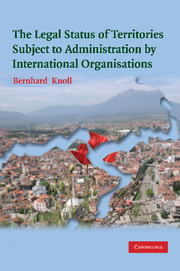Book contents
- Frontmatter
- Contents
- Illustrations
- Foreword: Pierre-Marie Dupuy
- Acknowledgements
- Table of Cases and Judicial Decisions
- List of Abbreviations
- Introduction
- 1 Creation of internationalised territories
- 2 Fiduciary administration: mandates, trust and the transitory sovereignty vacuum
- 3 Self-determination and the personality of internationalised territories
- 4 ‘The King's two bodies’: the dual functions of international administrations
- 5 Extent of UN authority in Kosovo and the problem of an open-ended institution-building mandate
- 6 The status process: Kosovo's endgame
- 7 An anomalous legitimacy cycle
- 8 Properties of a transitory legal order
- Concluding appraisal
- Bibliography
- Index
4 - ‘The King's two bodies’: the dual functions of international administrations
Published online by Cambridge University Press: 11 August 2009
- Frontmatter
- Contents
- Illustrations
- Foreword: Pierre-Marie Dupuy
- Acknowledgements
- Table of Cases and Judicial Decisions
- List of Abbreviations
- Introduction
- 1 Creation of internationalised territories
- 2 Fiduciary administration: mandates, trust and the transitory sovereignty vacuum
- 3 Self-determination and the personality of internationalised territories
- 4 ‘The King's two bodies’: the dual functions of international administrations
- 5 Extent of UN authority in Kosovo and the problem of an open-ended institution-building mandate
- 6 The status process: Kosovo's endgame
- 7 An anomalous legitimacy cycle
- 8 Properties of a transitory legal order
- Concluding appraisal
- Bibliography
- Index
Summary
Membership of any association presupposes a dividing line between insiders and outsiders, a rule laying down criteria of inclusion and exclusion. The twentieth century, however, witnessed the rise of unrecognised yet effective authorities stuck in transition somewhere between an international nullity and statehood, including individuals, peoples under colonial rule and de facto régimes. As highlighted at the 1994 Annual Meeting of the American Society of International Law, sub-state entities have an increasingly important role to play in international relations: ‘We have moved to a state at which, especially with respect to conflict resolution, non-state and sub-state actors are equal participants in the making of peace accords and in their implementation.’
‘Unbundling’ international legal personality has an undoubtedly wider significance for conceptualising membership in the international society. The propositions advanced so far fit well into an evolving legal framework that ascribes increasing capacities for non-state territorial actors to access international normative space. The imposition of international trusteeship in a post-colonial setting can therefore be presented in terms of inclusion in the sphere of international interest, rather than exclusion that thrives on notions of colonial inequality. Accordingly, we demonstrated that the imposition of what some commentators have termed ‘neo-trusteeship’ lends agency to an otherwise voiceless entity existing at the margins of an international legal nihil.
- Type
- Chapter
- Information
- The Legal Status of Territories Subject to Administration by International Organisations , pp. 149 - 183Publisher: Cambridge University PressPrint publication year: 2008

